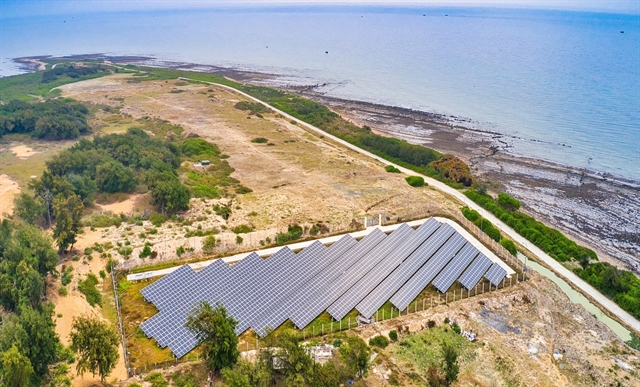 Environment
Environment


|
| A solar power project on Bạch Long Vỹ Island in the Gulf of Tonkin. — VNA/VNS Photo Nguyễn Đức Nghĩa |
HÀ NỘI — Green transition in the energy sector is a key trend in the world and one of Việt Nam's top priorities.
Việt Nam is among countries with great potential to invest in new renewable energy sources such as solar, wind and ocean wave power, and biogas.
According to experts, to take advantage of its inherent potential, Việt Nam needs to have incentive policies to expand the renewable energy market, promote and deploy new technologies, provide appropriate opportunities as well as encouraging the use of renewable energy in all important areas.
The world today still depends mainly on traditional energy such as oil, coal, and natural gas. However, these sources are gradually running out. According to scientists' calculations, they can only last 70 to 100 years.
Dr Chu Đức Hoàng, Chief of the Office of the National Technology Innovation Fund under the Ministry of Science and Technology, said traditional energy not only causes serious environmental pollution from greenhouses emissions that produce harmful effects to water and soil, but are also gradually depleting, posing a threat to stable energy supply in the future.
Việt Nam's energy industry has developed strongly in recent years, in all stages of exploration, exploitation, production, transmission, distribution and import and export of energy. However, the scale and efficiency of the energy industry are still low.
In particular, Việt Nam's energy demand is also increasing rapidly with about 10 per cent a year during 2001-10, about 7 per cent a year in the period from 2011 to present. Electricity demand climbed by 13 per cent a year during the 2001-10 and nearly 10 per cent a year from 2011 to present.
Greenhouse gas emissions from the energy sector accounted for about 63 per cent of Việt Nam's total greenhouse gas emissions in 2010 and about 67.7 per cent in 2020. Emissions are forecast to make up about 73.1 per cent and 79.7 per cent in 2030 and 2050 respectively according to the normal scenario.
The 26th Conference of the Parties participating in the United Nations Framework Convention on Climate Change (COP26) with strong political commitments of many countries, including Việt Nam, to reduce greenhouse gases shows the trend. Green energy production and consumption as well as energy transition are becoming an urgent and important issue in sustainable development strategies, associated with environmental protection of countries around the world.
Committing to achieving the goal of complete decarbonisation by mid-century makes Việt Nam an even more attractive destination for foreign corporations to invest in renewable energy infrastructure, including offshore wind power projects. With a coastline of more than 3,200km, shallow water depth and high, stable wind speed, Việt Nam fully meets the important prerequisites necessary to develop reliable offshore wind power projects.
Dr Hoàng said that facing the challenge of climate change and the risk of energy depletion, the transition to green energy is not just an option but an urgent need. In this transition, technology plays a key role. Technology will create efficient solutions for capturing and storing energy to optimising its use in both production and daily consumption. Therefore, technological innovation is an inevitable trend for countries, corporations, and businesses to successfully convert from traditional energy to clean energy. — VNS




